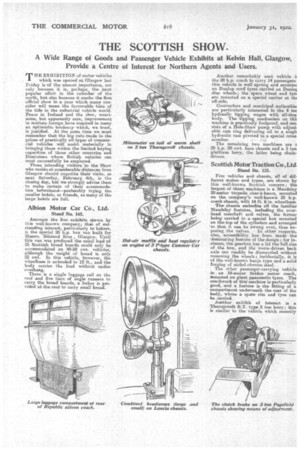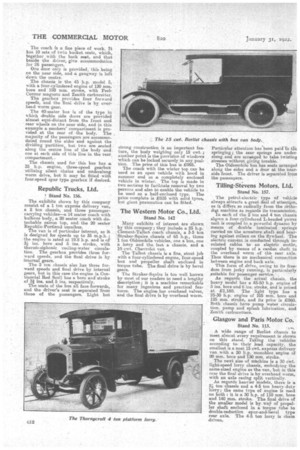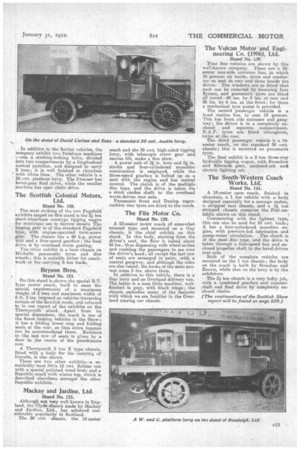THE SCOTTISH SHOW.
Page 10

Page 11

Page 12

Page 13

If you've noticed an error in this article please click here to report it so we can fix it.
A Wide Range of Goods and Passenger Vehicle Exhibits at Kelvin Hall, Glasgow, Provide a Centre of Interest for Northern Agents and Users,
THE EXHIBITION of motor vehicles which was opened at G/asgow last Friday is of the utmost, importance, not only because it is perhaps, the most popular affair in the calendar of the north, but also because it marks the first official show in a year which many consider will mean The. favourable turn of the tide in the melestrial vehicle world. Peace in Ireland and the slew, wearisome, but apparently sure, improvement in matters foreign have inspired in many an eptiraistic tendency which, we trust, is justified. At the same time we must remember that the big eats. made in the prices of practically all types of commercial vehiclee will assist materiallybringing these within the limited buyng capacities of those other countries and Dominions where British vehicles can most successfully be employed.
Those intending visitors to the Show who reside at considerable distances from Glasgow should expedite their visits:, as next. Saturday, February 4th, is the closing day, but we strongly advise them to make certain of their accommodation beforehand—preferably trying the smaller hotels, or friends, as many of the large hotels are full.
Albion Motor Car Co., Ltd.
Stand No. 145.
Amongst the tive exhibits shown by this well-known company, that of outstanding interest, particularly to bakers, is the special 20 h.p. boa an built. for Meesra. Ili/slam' Bros , Glasgow. Until this van was produced the usual toad of 35 Scottish. bread boards could only be accommodated on 40-50 cwt. vehicles, although the weight of bread is only 22 cwt. In this vehicle, however, the wheelbase is extended to /2 ft., and the body carries the lewd without. undue overhang.
There is a single luggage rail en the roof and five tiers of angle runners to carry the bread boards, a locker is provided at the rear to carry small bread.
Another remarkably neat vehicle the 20 lip. coach to carry 14 passengers this vehicle is well sprung and mountec on Dunlop cord tyres carried on Dunk' disc wheels; the spare wheel and tyre are mounted on a specie.' carrier at the off-side.
Contractors and municipal autheritiet are particularly, interested in the 4 ten hydraulic tipping wagon with allstee body. The tipping mechanism on thh machine is practically foolproof, and con. slats of a. Hele-Shaw pump with adjust• able cans ring delivering oil to a sine( hydraulic ram pivoted to a special crossmember.
The remaining two machines are a 20 haa. 30 cwt. bare chassis and a 3 ton platform leery, the latter being chain. driven.
Scottish Motor Traction C o., Ltd.
Stand No. 125.
Five vehielea and chassis, all of different makes and types, are shown by this well-known Scottish concern; the largest of these marhines is a Maudslay 28-seater torpedo. cha-r-a-bancs, mounted on the company's well-known 32 h-.p. coach chassis, with 14 ft. 6 in. wheelbase.
The ehaesie embodies all the familiar Mandalay featifies, including the overhead camshaft and valves, the former being carried in a special box mounted en the top of the eylinders and arranged 'so that, it eau be swung over, thus ex
posing the valves. In other respects, also, accessibility has been made the +laminatingfeature of the design; for instance, the gearbox has a lid the full size of the box, and the worm-driven back axle can readily be dismantled without removing the wheels ; incidentally, it is of the well-known banjo type and a solid forging of nickel-chrome steel.
The other passenger-carrying vehicle in an neeater Solden motor coach, mounted en giant pneumatic tyres. The coachwork of this machine is particularly good, and a feature is the fitting of a compartment underneath the rear of the body, where a spare rim and tyre can be carried.
Another exhibit of interest is a Thernycroft B.T. type 2 ten lorry; this is similar to the vehicle which recently carried out such successful tests under observation, and which was subsequently awarded the Dewar trophy for the most meritorious performance of the year in R.A.C. trials. The test was over a distance of 1,?2(30 miles, fully loaded, ard the.results obtained sheaved an average speed of 15.9 m.p.h. and a consumption of 13 miles per gallon of fuel.
Special features of the chassis are overhead inlet valves and detachable cylinder head, centrally positioned gate change and sub-frame mounting of engine, clutch and gearbox so that they can be removed as a unit
As regards machines for the carrying of goods, there are two chassis—a Citroen and a Vim ; the former is one of the smallest fonr-wheeled delivery cars made, and is practically identical with the well-known 10 hp. private-car chassis ; it is capable of carrying 5 cwt., and the body used with it has removable canvas covers. As this vehicle is imported free of duty, the price is certainly attractive.
The other chassis, the Vim, is a lowpriced, but sturdy machine capable of dealing satisfactorily with loads np to 15 cwt.
The four-cylindered monobloc engine is a compact little unit with enclosed valves and -detachable head; ignition is by high-tension magneto and carburation is attended to by a Zenith instru
merit Centrally positioned gate change is provided for the throe-speed-and-reverse gearbox, and the final drive is by way of an open oarclan slabft to an overhead warm, which -can be readily dismantled when required.
The 'equipment includes electric lighting and starting set, also electric born and demountable Tiff's.
Perk Motor Co., Ltd.
Starid No. 146.
• The A.k.C. exhibits wbioh are being shown on this stand by the Scottish agents of. the builders consist of a tipping wagon, a motor coach and a singledeck omnibus.
The tipper has a capacity of 4 tons, or 100 cubic ft., and its all-steel body is pivoted at the rear, being raised by a telesoopie hydraulic ram positioned between cab -and body. The tipping angle is 40 degrees, which can be attained in ,30 seeonds. The oil pump is of the gear typo, and is positively driven from the Fea-rbox, the pinup is engaged by a lever in the nab, while the cantro-lling lever is situated at the side of the chassis.
The coach is a fine piece of work. It has 10 sets of twin bucket seats, which, together with the back seat, and that beside the driver, give accommodation for 26 passengers. One door only is provided, this being on the near side, and a gangway is left down the centre.
The. chassis is the 45 h.p. model 5, with a four-cylindered engine of 120 mm. bore and 150 aim. stroke, with PeelConnor magneto and Zenith carburetter. The gearbox provides four forward speeds, and the final drive is by overhead worm gear.
The 40-seater bus is of the type in which -double side doors are provided almost equi-distant from the front and rear wheels on the near side and in this example a smokers' compartment is provided at the rear of the body. The majority of the passengers are accommodated round the sides and against the dividing paatition, but two are seated along the centre line of the body and one at each side of this line in the rear, compartment..
The chassis used for this bus has a 35 h.p. engine, three-speed gearbox utilizing silent chains and underslung worm drive, but it may be fitted with four-speed spur type gearbox if desired.
Republic Trucks, Ltd.
I Stand No. 156.
The exhibits shown by this company consist of a 1 ton express delivery van, a 2 ton chassis, and three passengercarrying vehicles—a 14 seater coach with
bulbous body, a 20 seater coach with detachable saloon top, and the 20 seater
Republic-Portland omnibus.
The van is of particular interest, as it is designed for speeds up to 35 m.p.h.; 'the engine is rated at 19.8 h.p. and is of3L ins, bore and 5 ins, stroke, with thermo-siphonic cooling-water circulation, The gearbox provides three forward speeds, and the final drive is by internal gears.
The 2 ton chassis also has three forward speeds and final drive by internal gears, but in this case the engine (a Continental Red Seal) has a bore and stroke of 3j ins. and 5 ins. respectively.
The seats of the bus all face forwards, and the driver's seat is separated from those of the passengers. Light but strong construction is an important feature, the body weighing only 18 cwt.; another point is the provision of windows winch can be locked securely in any position. The price of this bus is £995. The coach with the winter top can be used as an open vehicle with hood in summer and as ,a completely enclosed vehicle in winter. The top is made in two sections to facilitate removal by two persons and also to enable the vehicle to , be used as a half-enclosed type. The price complete is £935 with solid tyrea, but giant pneumatics can be fitted.
The Western Motor Co., Ltd.
Stand No. 142 Many exhibits of interest are 'shown by this company; they include a 25 h.p. ,Clement-Talbot coach chassis, a 3-5 ton . Straker-Squire chassis of 65 h.p., three 1 ton Oldsmobile vehicles, one a bus, one a lorry and the last a chassis, and a 10 cwt. Chevrolet van.
The Talbot chassis is a fine, stout job with a four-cylindered engine, four-speed box and propeller shaft enclosed in torque tube. The final drive is by bevel gears.
The Straker-Squire is too well known by most of our readers to need a lengthy description; it is a machine remarkable for many ingenious and practical features. The engine has overhead valves, and the final drive is by overhead worm.
Particular attention has.been paid g0 springing; the rear springs are under. slung and are arranged to take twisting stresses without giving trouble.
The Oldsmobile bus has seats arranged along the sides and a door at the nearside front. The driver is separated from the passengers.
Tilling-Stevens Motors, Ltd.
Stand No. 157.
The petrol-electric type of vehicle always attracts a great deal of attention, as it differs so radically from the cirthodax machine as regards its transmission. In each of the 2 ton and 4 ton chassis shpwn a four.cylindered L-headed power unit is coupled to a, powerful dynamo by means of double laminated springs carried on the armature shaft and bearing against rollers on the flywheel. The electric current is conducted through insulated cables to an electric motor, coupled •by means of a cardan shaft to the overhead worm of the rear axle. Thus there is no mechanical connection between engine and back axle.
This form of .drive, owing to its freedom from jerky running, is particularly suitable for passenger service, _ As regards the actual chassis, the, heavy model has a 45-50 h.p. engine of 5 ins, bore and 6 ins, stroke, and is priced at £1,160. The light type has a 25-30 lap. engine of 105 mm. bore and 125 nun. stroke, and its price is £860. Roth chassis have pump water circulation, pump and splash lubrication, and Zenith carburetters.
Glasgow and Paris Motor Co.
Stand No. 113.
A wide range of Bernet chassis to meet almost every requirement is shown on this stand. Taking the vehicles according to their load capacity, the smallest is ,a neat 15 cwt. express delivery van with a 20 lap. monobloc engine of
90 mm. bole and 130 mm. stroke. _
The next size of machine is a 30 cwt. light-speed lorry chassis, embodying the same-sized engine as the van, but in this case the final drive is by overhead worm, with an axle casing split vertically.
As regards heavier models, there is a ton chassis and a 4-5 ton heavy-duty lorry; the same type of engine is used on both : it is a 30 h.p. of 110 mm. bore and 140 mm. stroke. The final drive of the smaller model is by .waSa of propeller shaft enclosed in a torque tube to double-reduction spur-and-bevel type rear axle. The 4-5 ton lorry is chain driven.
In addition to the Berliet vehicles, the company exhibit two Delahaye machines —one a striking-looking lorry, divided into two compartments by a longitudinal central partition, and designed to carry 2 tons; it is well finishedin chocolate ` with white lines. The other vehicle is a 30 cwt. platform lorry. The 2-tonner has bevel-gear final drive, while the smaller machine has open chain drive.
The Scottish Colonial Motors, • Ltd.
Stand No. 158:
The most striking of the two Pagefield exhibits staged on this stand is the 3i ton short-wheklbase evertype tipping wagon for municipal use in narrow streets. The tipping gear is of the standard Pagefield type, with engine-operated twin-screw gear. The chassis has a 40 h.p. power unit and a four-speed gearbox; the final drive is by overhead worm gearing.
The other exhibit is a bare chassis on Michelin pneumatic tyres and disc wheels; this is suitable either for coachwork or for. carrying 3 ton loads..
Bryson Bros.
Stand No. 153.
On this stand is shown the special B.T. type motor coach, built to meet the special requirements of a. maximum weight of 3 tons and maximum width of 6 ft. 3 ins, imposed on vehicles traversing certain of the Scottish roads, and referred to in our report of the exhibits on the Thorn ycroft stand. Apart from its special dimensions, the coach is one of the finest looking vehicles in the Show ; it has a folding lower step and folding seats at the rear, so that extra luggage can be accommodated there. Entrance to the last row of seats is given by a door in the centre of the penultimate TOW.
A Thernycroft 3 ton X type chassis, fitted with a body for the carrying of biscuits, is also shown.
There are two other exhibits—a remarkably 'neat little 12 cwt. Belsize van with a special polished wood body and a Republic coach with winter top, which is described elsewhere amongst the other Republic exhibits.
• Mackay and Jardine, Ltd.
Stand No. 123.
Although not very well known in England, the Clyde chassis made by Mackay and Jardine, Ltd., has achieved considerable popularity in Scotland. The 30 cwt. chassis, the 14-seater coach and the 30 cwh high-sided tipping lorry, with telescopic screw gear and canvas tilt, make a fine show.
A power unit of 3i in. bore and 51k in• stroke and four-cylindered monobloc construction is employed, while the three-speed gearbox is bolted up as a unit with the engine and has central control. The clutch is of the multiple disc type, and the drive is taken via a stout cardan shaft to the overhead worm-driven rear axle.
Pneumatic front and Dunlop supercushion rear tyres are fitted to the coach.
The Fife Motor Co.
Stand No. 128.
A 23-seater motor coach of somewhat unusual type and mounted on a Guy chassis, is the chief exhibit on this stand. In this body, starting from the driver's seat, the floor is raised about 16 ins., thus dispensing with wheel arches and enabling the passengers to see over the driver's head; all except the last row of seats are arranged in pairs, with a central gangway,, and although the sides are also raised, the backs of the seats project some 5 ins, above them.
In addition to this vehicle, there is a Guy lorry and an Overland delivery van. The latter is a neat little machine, well. finished in grey, with black wings; the chassis embodies many of the features with which we are familiar in the Overland touring ear chassis.
The Vulcan Motor 'and Engineering Co. (1906), Ltd.
Stand'No. 139.
"-Four fine vehicles are shown by this well-known company. These are a 22seater rear-side entrance bus, in which 16 persons sit. inside, three and conductor on seat at rear and three beside the driver. The windows are so fitted that each can be removed by loosening four tlynuts, and pneumatic tyres are fitted all round 10 ins. by 8 ins, at rear and 36 ins. by 6 ins, at the front; for these a mechanical tyre pump is provided.
The second passenger vehicle is a hotel station bus, to seat 14 persons. This has front side entrance and gang-. way ; the driver it in a completely enclosed and separate compartment. N.A.P. tyres are. fitted throughout., twins at the rear.
The third passenger vehicle is a 16seater coach, on the standard 30 cwt. chassis; this is mounted on pneumatic tyres.
The final exhibit is a 2 ton three-way hydranlic tipping wagon, with Bromilow and Edwards gear, enclosed cab anct electric lighting set.
The South-Western Coach Works. Ltd:
Stand No. 141.
A 14-seater open coach, finished in chocolate, a 1 ton vehicle with a body. designed especially for a sausage maker, a stripped taxi chassisl and a 3i tori stripped chassis comprise ths Fiat ex
hibits shown on this stand. '
Commencing with the lightest type,. 'this can also be used for 10 cwt, loads; it has a four-cylindered monohloc engine, with pressure-fed lubrication and pump-water circulation. The clutch is of the steel disc type, and the drive is taken through a four-speed box and on closed propeller shaft to the bevel-driven rear axle.
Both of the complete vehicles are mounted on the 1 ton chassis; the body on the coach is built by Strachan and Brown, while that on the lorry is by the exhibitors.
• The 31 ton chassis is a very hefty job, with a combined gearbox and counter. shaft. and final drive by completely enclosed chains.
(The continuation of the Scottish .Show report will be found on page 828.)




































